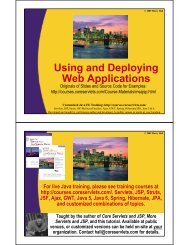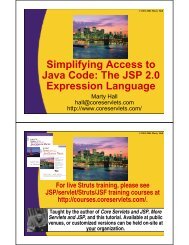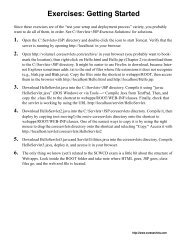Invoking Java Code with JSP Scripting Elements - Java Programming
Invoking Java Code with JSP Scripting Elements - Java Programming
Invoking Java Code with JSP Scripting Elements - Java Programming
Create successful ePaper yourself
Turn your PDF publications into a flip-book with our unique Google optimized e-Paper software.
© 2012 Marty Hall<strong>Invoking</strong> <strong>Java</strong> <strong>Code</strong> <strong>with</strong><strong>JSP</strong> <strong>Scripting</strong> <strong>Elements</strong>Originals of Slides and Source <strong>Code</strong> for Examples:http://courses.coreservlets.com/Course-Materials/csajsp2.html2Customized <strong>Java</strong> EE Training: http://courses.coreservlets.com/<strong>Java</strong>, JSF 2, PrimeFaces, Servlets, <strong>JSP</strong>, Ajax, jQuery, Spring, Hibernate, RESTful Web Services, Hadoop, Android.Developed and taught by well-known author and developer. At public venues or onsite at your location.© 2012 Marty HallFor live <strong>Java</strong> EE training, please see training coursesat http://courses.coreservlets.com/.JSF 2, PrimeFaces, Servlets, <strong>JSP</strong>, Ajax (<strong>with</strong> jQuery), GWT,Android development, <strong>Java</strong> 6 and 7 programming,SOAP-based and RESTful Web Services, Spring, Hibernate/JPA,XML, Hadoop, and customized combinations of topics.Taught by the author of Core Servlets and <strong>JSP</strong>, MoreServlets and <strong>JSP</strong>, and this tutorial. Available at publicvenues, or customized versions can be held on-site at yourCustomized <strong>Java</strong> EE Training: http://courses.coreservlets.com/<strong>Java</strong>, JSF 2, PrimeFaces, Servlets, <strong>JSP</strong>, Ajax, jQuery, Spring, Hibernate, RESTful Web Services, Hadoop, Android.organization. Contact hall@coreservlets.com for details.Developed and taught by well-known author and developer. At public venues or onsite at your location.
Agenda• Static vs. dynamic text• Dynamic code and good <strong>JSP</strong> design• <strong>JSP</strong> expressions• Servlets vs. <strong>JSP</strong> pages for similar tasks• <strong>JSP</strong> scriptlets• <strong>JSP</strong> declarations• Predefined variables• Comparison of expressions, scriptlets, anddeclarations• XML syntax for <strong>JSP</strong> pages4© 2012 Marty HallIntro5Customized <strong>Java</strong> EE Training: http://courses.coreservlets.com/<strong>Java</strong>, JSF 2, PrimeFaces, Servlets, <strong>JSP</strong>, Ajax, jQuery, Spring, Hibernate, RESTful Web Services, Hadoop, Android.Developed and taught by well-known author and developer. At public venues or onsite at your location.
Uses of <strong>JSP</strong> Constructs6SimpleApplicationComplexApplication• <strong>Scripting</strong> elements calling servletcode directly• <strong>Scripting</strong> elements calling servletcode indirectly (by means of utilityclasses)• Beans• Servlet/<strong>JSP</strong> combo (MVC)• MVC <strong>with</strong> <strong>JSP</strong> expression language• Custom tags• MVC <strong>with</strong> beans, custom tags, anda framework like JSF 2.07Design Strategy: Limit <strong>Java</strong><strong>Code</strong> in <strong>JSP</strong> Pages• You have two options– Put 25 lines of <strong>Java</strong> code directly in the <strong>JSP</strong> page– Put those 25 lines in a separate <strong>Java</strong> class and put 1 linein the <strong>JSP</strong> page that invokes it• Why is the second option much better?– Development. You write the separate class in a <strong>Java</strong>environment (editor or IDE), not an HTML environment– Debugging. If you have syntax errors, you see themimmediately at compile time. Simple print statements canbe seen.– Testing. You can write a test routine <strong>with</strong> a loop thatdoes 10,000 tests and reapply it after each change.– Reuse. You can use the same class from multiple pages.
Basic Syntax• HTML Text– Blah– Passed through to client. Really turned into servlet codethat looks like• out.print("Blah");• HTML Comments– – Same as other HTML: passed through to client• <strong>JSP</strong> Comments– – Not sent to client• Escaping
© 2012 Marty Hall<strong>JSP</strong> Expressions:10Customized <strong>Java</strong> EE Training: http://courses.coreservlets.com/<strong>Java</strong>, JSF 2, PrimeFaces, Servlets, <strong>JSP</strong>, Ajax, jQuery, Spring, Hibernate, RESTful Web Services, Hadoop, Android.Developed and taught by well-known author and developer. At public venues or onsite at your location.<strong>JSP</strong> Expressions11• Format– • Result– Expression evaluated, converted to String, and placedinto HTML page at the place it occurred in <strong>JSP</strong> page– That is, expression placed in _jspService inside out.print• Examples– Current time: – Your hostname: • XML-compatible syntax– <strong>Java</strong> Expression– You cannot mix versions <strong>with</strong>in a single page. You mustuse XML for entire page if you use jsp:expression.• See slides at end of this lecture
<strong>JSP</strong>/Servlet Correspondence• Original <strong>JSP</strong>A Random Number• Representative resulting servlet codepublic void _jspService(HttpServletRequest request,HttpServletResponse response)throws ServletException, IOException {response.setContentType("text/html");HttpSession session = request.getSession();JspWriter out = response.getWriter();out.println("A Random Number");out.println(Math.random());...}12<strong>JSP</strong> Expressions: Example…<strong>JSP</strong> ExpressionsCurrent time: Server: Session ID: The testParam form parameter:13
Predefined Variables14• request– The HttpServletRequest (1st argument to service/doGet)• response– The HttpServletResponse (2nd arg to service/doGet)• out– The Writer (a buffered version of type JspWriter) used tosend output to the client• session– The HttpSession associated <strong>with</strong> the request (unlessdisabled <strong>with</strong> the session attribute of the page directive)• application– The ServletContext (for sharing data) as obtained viagetServletContext().Comparing Servlets to <strong>JSP</strong>:Reading Three Params (Servlet)15@WebServlet("/three-params")public class ThreeParams extends HttpServlet {public void doGet(HttpServletRequest request,HttpServletResponse response)throws ServletException, IOException {…out.println(docType +"\n" +""+title + "\n" +"\n" +"" + title + "\n" +"\n" +" param1: "+ request.getParameter("param1") + "\n" +" param2: "+ request.getParameter("param2") + "\n" +" param3: "+ request.getParameter("param3") + "\n" +"\n" +"");}}
Reading Three Params (Servlet):Result1617Comparing Servlets to <strong>JSP</strong>:Reading Three Params (<strong>JSP</strong>)Reading Three Request ParametersReading Three Request Parametersparam1:param2:param3:
Reading Three Params(Servlet): Result18© 2012 Marty Hall<strong>JSP</strong> Scriptlets:19Customized <strong>Java</strong> EE Training: http://courses.coreservlets.com/<strong>Java</strong>, JSF 2, PrimeFaces, Servlets, <strong>JSP</strong>, Ajax, jQuery, Spring, Hibernate, RESTful Web Services, Hadoop, Android.Developed and taught by well-known author and developer. At public venues or onsite at your location.
<strong>JSP</strong> Scriptlets: Example• Suppose you want to let end userscustomize the background colorof a page– What is wrong <strong>with</strong> the following code?22<strong>JSP</strong> Scriptlets: ExampleColor TestingTesting a Background of"".23
<strong>JSP</strong> Scriptlets: Result2425Using Scriptlets to Make Partsof the <strong>JSP</strong> File Conditional• Point– Scriplets are inserted into servlet exactly as written– Need not be complete <strong>Java</strong> expressions– Complete expressions are usually clearer and easier tomaintain, however• Example– Have a nice day!Have a lousy day!• Representative result– if (Math.random() < 0.5) {out.println("Have a nice day!");} else {out.println("Have a lousy day!");}
© 2012 Marty Hall<strong>JSP</strong> Declarations:26Customized <strong>Java</strong> EE Training: http://courses.coreservlets.com/<strong>Java</strong>, JSF 2, PrimeFaces, Servlets, <strong>JSP</strong>, Ajax, jQuery, Spring, Hibernate, RESTful Web Services, Hadoop, Android.Developed and taught by well-known author and developer. At public venues or onsite at your location.<strong>JSP</strong> Declarations• Format– • Result– <strong>Code</strong> is inserted verbatim into servlet’s class definition,outside of any existing methods• Examples– – • Design consideration– Fields are clearly useful. For methods, it is usually betterto define the method in a separate <strong>Java</strong> class.• XML-compatible syntax– <strong>Java</strong> <strong>Code</strong>27
<strong>JSP</strong>/Servlet Correspondence• Original <strong>JSP</strong>Some Heading28• Better alternative:– Make randomHeading a static method in a separate class<strong>JSP</strong>/Servlet Correspondence29• Possible resulting servlet codepublic class xxxx implements HttpJspPage {private String randomHeading() {return("" + Math.random() + "");}public void _jspService(HttpServletRequest request,HttpServletResponse response)throws ServletException, IOException {response.setContentType("text/html");HttpSession session = request.getSession();JspWriter out = response.getWriter();out.println("Some Heading");out.println(randomHeading());...} ...}
<strong>JSP</strong> Declarations: Example<strong>JSP</strong> Declarations<strong>JSP</strong> DeclarationsAccesses to page since server reboot:30<strong>JSP</strong> Declarations: Result31
<strong>JSP</strong> Declarations: thejspInit and jspDestroy Methods• <strong>JSP</strong> pages, like regular servlets, sometimeswant to use init and destroy• Problem: the servlet that gets built from the<strong>JSP</strong> page might already use init and destroy– Overriding them would cause problems.– Thus, it is illegal to use <strong>JSP</strong> declarations to declareinit or destroy.• Solution: use jspInit and jspDestroy.– The auto-generated servlet is guaranteed to call thesemethods from init and destroy, but the standard versionsof jspInit and jspDestroy are empty (placeholders for youto override).3233<strong>JSP</strong> Declarations andPredefined Variables• Problem– The predefined variables (request, response, out, session,etc.) are local to the _jspService method. Thus, they arenot available to methods defined by <strong>JSP</strong> declarations or tomethods in helper classes. What can you do about this?• Solution: pass them as arguments. E.g.public class SomeClass {public static void someMethod(HttpSession s) {doSomethingWith(s);}}…• Notes– Same issue if you use methods in <strong>JSP</strong> declarations• But separate classes preferred over <strong>JSP</strong> declarations– println of <strong>JSP</strong>Wwriter throws IOException• Use “throws IOException” for methods that use println
© 2012 Marty HallComparing <strong>JSP</strong><strong>Scripting</strong> <strong>Elements</strong>34Customized <strong>Java</strong> EE Training: http://courses.coreservlets.com/<strong>Java</strong>, JSF 2, PrimeFaces, Servlets, <strong>JSP</strong>, Ajax, jQuery, Spring, Hibernate, RESTful Web Services, Hadoop, Android.Developed and taught by well-known author and developer. At public venues or onsite at your location.Using Expressions, Scriptletsand Declarations• Task 1– Output a bulleted list of five random ints from 1 to 10.• Since the structure of this page is fixed and we use aseparate helper class for the randomInt method,<strong>JSP</strong> expressions are all that is needed.• Task 2– Generate a list of between 1 and 10 entries (selected atrandom), each of which is a number between 1 and 10.• Because the number of entries in the list is dynamic, a<strong>JSP</strong> scriptlet is needed.• Task 3– Generate a random number on the first request, then showthe same number to all users until the server is restarted.• Instance variables (fields) are the natural way toaccomplish this persistence. Use <strong>JSP</strong> declarations for this.35
Helper Class: RanUtilitiespackage coreservlets; // Always use packages!!/** Simple utility to generate random integers. */public class RanUtilities {/** A random int from 1 to range (inclusive). */public static int randomInt(int range) {return(1 + ((int)(Math.random() * range)));}36public static void main(String[] args) {int range = 10;try {range = Integer.parseInt(args[0]);} catch(Exception e) { // Array index or number format// Do nothing: range already has default value.}for(int i=0; i
Task 1: <strong>JSP</strong> Expressions(Result)3839Task 2: <strong>JSP</strong> Scriptlets(<strong>Code</strong>: Version 1)Random List (Version 1)Random List (Version 1)Again, you can import the package <strong>with</strong> ,then omit the package name in the calls to the static method.
Task 2: <strong>JSP</strong> Scriptlets(Result: Version 1)40Task 2: <strong>JSP</strong> Scriptlets(<strong>Code</strong>: Version 2)Random List (Version 2)Random List (Version 2)
Task 2: <strong>JSP</strong> Scriptlets(Result: Version 2)42Task 3: <strong>JSP</strong> Declarations(<strong>Code</strong>)43Semi-Random NumberSemi-Random Number:
Task 3: <strong>JSP</strong> Declarations(Result)44© 2012 Marty Hall<strong>JSP</strong> Pages <strong>with</strong>XML Syntax45Customized <strong>Java</strong> EE Training: http://courses.coreservlets.com/<strong>Java</strong>, JSF 2, PrimeFaces, Servlets, <strong>JSP</strong>, Ajax, jQuery, Spring, Hibernate, RESTful Web Services, Hadoop, Android.Developed and taught by well-known author and developer. At public venues or onsite at your location.
Why Two Versions?46• Classic syntax is not XML-compatible– , , are illegal in XML– HTML 4 is not XML compatible either– So, you cannot use XML editors like XML Spy• You might use <strong>JSP</strong> in XML environments– To build xhtml pages– To build regular XML documents• You can use classic syntax to build XML documents, but itis sometimes easier if you are working in XML to start <strong>with</strong>– For Web services– For Ajax applications• So, there is a second syntax– Following XML rulesXML Syntax for Generating XHTMLFiles (somefile.jspx)Some TitleBodyThe jsp namespace is required if youuse jsp:blah commands. You can useother namespaces for other custom taglibraries.For <strong>JSP</strong> pages in XML syntax, default contenttype is text/xml.Normal xhtml content, plus <strong>JSP</strong> commands that usejsp:blah syntax, plus <strong>JSP</strong> custom tag libraries.47
XML Syntax for Generating RegularXML Files (somefile.jspx)foobar• Uses– When you are sending to client that expects real XML• Ajax• Web services• Custom clients– Note• You can omit the xmlns declaration if you are not usingany <strong>JSP</strong> tags. But then you could just use .xml extension.48XML Syntax for Generating HTML 4Files (somefile.jspx)• Many extra steps required– Enclose the entire page in jsp:root– Enclose the HTML in CDATA sections• Between • Because HTML 4 does not obey XML rules– Usually not worth the bother49
Sample HTML 4 Page: ClassicSyntax (sample.jsp)Sample (Classic Syntax)Sample (Classic Syntax)Num1: Num2: Num3: 50Sample XHTML Page: XML Syntax(sample.jspx)51Sample (XML Syntax)Sample (XML Syntax)Num1: Math.random()*10double num2 = Math.random()*100;Num2: num2private double num3 = Math.random()*1000;Num3: num3
Sample Pages: Results52XML Document Generated <strong>with</strong>XML SyntaxTextNumber:Math.random()*1053
Summary54• <strong>JSP</strong> Expressions– Format: – Wrapped in out.print and inserted into _jspService• <strong>JSP</strong> Scriptlets– Format: – Inserted verbatim into the servlet’s _jspService method• <strong>JSP</strong> Declarations– Format: – Inserted verbatim into the body of the servlet class• Predefined variables– request, response, out, session, application• Limit the <strong>Java</strong> code that is directly in page– Use helper classes, beans, servlet/<strong>JSP</strong> combo (MVC),<strong>JSP</strong> expression language, custom tags• XML Syntax– There is alternative <strong>JSP</strong> syntax that is sometimes useful whengenerating XML-compliant documents, probably for Ajax apps.• But is more trouble than it is worth for most HTML applications© 2012 Marty HallQuestions?JSF 2, PrimeFaces, <strong>Java</strong> 7, Ajax, jQuery, Hadoop, RESTful Web Services, Android, Spring, Hibernate, Servlets, <strong>JSP</strong>, GWT, and other <strong>Java</strong> EE training55Customized <strong>Java</strong> EE Training: http://courses.coreservlets.com/<strong>Java</strong>, JSF 2, PrimeFaces, Servlets, <strong>JSP</strong>, Ajax, jQuery, Spring, Hibernate, RESTful Web Services, Hadoop, Android.Developed and taught by well-known author and developer. At public venues or onsite at your location.

















